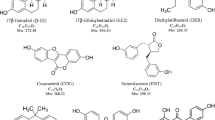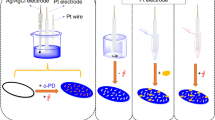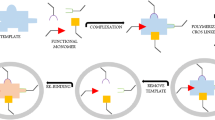Abstract
hER-MIP is a molecularly imprinted polymer (MIP) that has been shown to selectively collect human estrogen receptor (hER) binding active substances. However, environmental samples contain various chemicals depending on the location and regional differences, and the hER binding activity depends on the sample type. Thus, the general applicability of hER-MIP to actual environmental samples must be elucidated. In this study, 48 environmental samples were collected and screened with hER-MIP, and a yeast assay was performed to evaluate the adsorption characteristics of the samples according to the adsorption and elution fractions. The results showed that hER-MIP collects hER binding active substances almost selectively but does not collect constitutive androstane receptor (CAR) binding active substances selectively. CAR binding activity was detected in the adsorbed fraction because several hER binding active substances also demonstrate CAR binding activity.
Similar content being viewed by others
Explore related subjects
Discover the latest articles, news and stories from top researchers in related subjects.Avoid common mistakes on your manuscript.
Endocrine disrupting chemicals (EDCs) are a newly defined category of environmental pollutants that interfere with or unintentionally promote the functioning of the endocrine system (Colborn et al. 1993). Estrogenic EDCs are a subclass of EDCs that comprise either natural or synthetic hormonal estrogens that can mimic or induce an estrogen-like response in an organism. There are four main classes of estrogenic EDCs: natural steroidal estrogens [e.g., 17β-Estradiol (E2), estrone (E1), estriol (E3)], synthetic estrogens [e.g., 17α-ethinylestradiol (EE2), and diethylstilbestrol], phytoestrogens (e.g., isoflavone and coumestrol), and various industrial chemicals like xenoestrogens (e.g., bisphenol A, 4-nonylphenol, and 4-tert-octylphenol). The various estrogenic EDCs can differ by several orders of magnitude with respect to their estrogenic potency (Shiraishi et al. 2018). Cargouët et al. (2004) reported that environmental samples contain several unknown estrogenic EDCs. They performed gas chromatography–mass spectrometry analysis to quantify E1, E2, E3, and EE2, and they found that samples from a wastewater treatment plant showed an estimated estrogenic activity that was 2–2.5 times lower than in vitro estrogenic activity. Additionally, this reason is explained by the results reported; 84% of total estrogen was removed in the sewage treatment plants that combined three processes (anaerobic pond, biological filter, and wetlands) (Kiambe et al., 2020). Searching for unknown estrogenic EDCs requires the efficient and selective concentration of dilute human estrogen receptor (hER) binding activity in environmental samples. We previously developed the substrate hER-MIP, which is a molecularly imprinted polymer (MIP) that specifically concentrates hER binding activity. We improved the typical MIP preparation procedure using a hydrophilic matrix with a polyethylene glycol (PEG)-based crosslinker and a hydrophobic monomer to imitate the hydrophobic pocket of hER. An optimized MIP prepared with methacrylic acid as an additional functional monomer and E3, an analogue of E2, exhibited highly selective adsorption for hER-active compounds such as E2 and E3, with significant suppression of non-specific hydrophobic adsorption. Then we found that hER-MIP can selectively collect and purify estrogenic EDCs from environmental samples (Yagishita et al. 2019).
To verify the general applicability of hER-MIP to environmental samples, we collected 48 samples from rivers and effluents of wastewater treatment plants. hER-MIP was applied to the collection of estrogenic activity. The selectivity of hER-MIP was evaluated by simultaneously measuring the constitutive androstane receptor (CAR) binding activity, which has different ligands and receptors from hER.
Methods
All samples were collected on sunny days between the summer of 2016 and winter of 2017. Table 1 lists the latitude and longitude of the sampling points. In total, 48 samples were collected: 37 samples of general river water, 8 samples of effluent from sewage treatment plants, and 3 samples of river water affected by the effluent. Each sample was sampled and transported in a glass bottle.
In the future, we aim to pass a large amount of water through the MIP. In the present study, however, we used a cartridge-type MIP, so the sample amount could not be increased. Therefore, 1 L of the environmental sample was extracted and concentrated with a C18 disk and then re-dissolved with methanol. Then, 50 mL of pure water was added to the re-dissolved sample to prepare a simulated environmental sample.
For the C18 method, 1 L of the water sample was passed through a glass fiber filter to remove suspended solids (SS). The filtered sample was then passed through a C18 disk conditioned with methanol. The C18 disk was dried, and the substance on the disk was eluted with methanol (C18 extract). The extract was then dried and used for the bioassay or processed further with the MIP method described below.
For proposed MIP method, 50 mL of MilliQ water was added to a sample pretreated with the C18 method. The sample was then passed through an MIP cartridge washed with acetonitrile and MilliQ water. The fraction that passed through the MIP cartridge without adsorption was concentrated on the C18 disk and labeled as the “through sample.” The through sample was then used for the bioassay. The fraction that adsorbed on the MIP cartridge was labeled as the “trap sample.” The trap sample was then eluted with acetonitrile and then used for the bioassay. The MIP method obtains both the eluted and adsorbed fractions (i.e., through and trap samples, respectively), as opposed to the C18 method that only obtains the eluted fraction.
hER α and CAR can be introduced to yeast by an expression plasmid (pGBT9-RLBD) of the ligand binding region of the receptor and DNA binding region of the transcriptional activator GAL and the core. The expression plasmid (pGAAD424-TF-2) for the transcriptional activation region of the coactivators TIF2 and GAL was introduced to the yeast strain Y190, for which the reporter gene β-galactosidase was incorporated. The test method was a modified version of that reported by Shiraishi et al. (2000). Here, 0.88% glucose was added to a test sample serially diluted with an improved synthetic defined medium (without tryptophan and leucine) on a 96-well black plate, and yeast was cultured at 30°C for 24 h. The sample was exposed to DMSO at a concentration of 1% for 4 h. A solution of Zymolyase 100 T was added to all wells and allowed to react with the samples at 37°C for 1 h. Then, the β-galactosidase chemiluminescent substrate Galactone Star solution was added and allowed to react at 30°C for 10 min. Finally, a luminometer (Luminescencer-JNR, AB-2100, ATTO) was used to quantify the chemiluminescence of each well. The luminescence of the test sample at each dilution ratio was taken as the average of two wells on the basis of the integrated value for each well over a timeframe of 1 s. The measured values were used to plot a dilution factor–emission curve, and a concentration (EC × 10) indicating an emission intensity 10 times that of the solvent control was obtained from the portion showing a linear increase. The sample was measured by a dipricate cell and evaluated using the average value. If the values in the two cells were significantly different, they were retested. E2 was measured as a positive control on each test day, and the activity of the sample was calculated by converting it to E2 and comparing it with the E2 activity on that day.
Results and Discussion
hER binding activity was detected in 18 of the 36 river water samples. Strong binding activity was detected in the effluents and river water affected by effluents compared with the river water without sewage discharge. This indicates that the hER binding activity originates from anthropogenic contamination. CAR binding activity was detected in all 48 samples. Figure 1 indicates no correlation between the hER and CAR binding activities of the samples. Kamata et al. (2018) and Shiraishi et al. (2018) reported at least 98 chemicals of the 583 tested chemicals have both hER and CAR binding activities, including p–t-octylphenol, diethylstilbestrol, and hexestrol.
hER binding activity was detected in the adsorption fraction (i.e., trap samples) of all samples identified as positive by the C18 method. In the screening of hER binding activity, the average recovery rate of hER binding activity (trap sample/C18 method) was 97% for the positive samples. Almost all of the hER binding activity of 18 environmental samples was captured by the MIP. This means that hER-MIP can be applied to various environmental samples. The bar graph in Fig. 2 shows the hER binding activity detected with the C18 method, and the pie chart shows the recovery rate calculated with the MIP method. The eluted fractions (i.e., through samples) that passed through without being trapped by the MIP were negative for hER binding activity, except for two samples. As shown in Table 1, these two samples were from the same sewage treatment plant.
There was no correlation between the strength of hER binding activity and the recovery rate of the MIP method. Several samples showed a recovery rate of over 100%, which indicates that the hER binding activity was higher than that detected by the C18 method for the same sample (i.e., trap > C18). This result indicates that the MIP cartridge had a purification effect. Several samples showed a recovery rate of below 100%, which indicates that the hER binding activity was lower than that detected by the C18 method for the same sample (i.e., trap < C18). This means that the MIP cartridge may trap hER binding chemicals strongly that cannot be eluted by acetonitrile. The chemicals trapped by MIP may be eluted by acid. If these strongly trapped chemicals are unknown estrogens, then the MIP method can be effective applied to searching for unknown substances.
For comparison, the same samples were screened for CAR binding activity. Such activity was detected in all samples. The bar graph in Fig. 3 shows the CAR binding activity detected by the C18 method, and the pie chart shows the recovery rate calculated by the MIP method. The recovery rate of the CAR binding activity from the adsorbed fraction (i.e., trapped samples) was approximately 50% on average, which is lower than that of the hER binding activity. CAR binding activity was also detected in the eluted fraction (i.e., through samples) for several samples.
If hER_MIP captures most lipophilic substances as well as C18 method, both hER and CAR binding activity will recover the total activity. However, from Figs. 2 and 3, in the sample purified using hER_MIP, although almost all the hER binding activity could be recovered, and most of the CAR binding activity was lost. This indicates that the results of this bioassay show that hER-MIP selectively collects hER-binding active substances.
The CAR binding activity in the purified sample is attributed to a substance having both hER and CAR binding activities. For example, p–t-octylphenol and diethylstilbestrol are known to have both activities, and it is possible that these effects are present.
Conclusion
In this study, 48 environmental samples were screened with the previously reported hER-MIP, and a yeast assay was performed to characterize the samples according to the adsorption and elution fractions. The results showed that hER-MIP selectively collects hER binding active substances. The results for the recovery rate of hER binding activity indicate that the MIP trapped unknown estrogenic chemicals that mimic hER binding. The MIP method is effective for searching unknown estrogenic chemicals.
References
Cargouët M, Perdiz D, Mouatassim-Souali A, Tamisier-Karolak S, Levi Y (2004) Assessment of river contamination by estrogenic compounds in Paris area (France). Sci Total Environ 324:55–66. https://doi.org/10.1016/j.scitotenv.2003.10.035
Colborn T, Saal FSV, Soto AM (1993) Developmental effects of endocrine-disrupting chemicals in wildlife and humans. Environ Health Persp 101:378–384. https://doi.org/10.1289/ehp.93101378
Kamata R, Nakajima D, Shiraishi F (2018) Agonistic effects of diverse xenobiotics on the constitutive androstane receptor as detected in a recombinant yeast-cell assay. Toxicol Vitro 46:335–348. https://doi.org/10.1016/j.tiv.2017.09.014
Kibambe MG, Momba MNB, Daso AP, Van Zijl MC, Coetzee MAA (2020) Efficiency of selected wastewater treatment processes in removing estrogen compounds and reducing estrogenic activity using the T47D-KBLUC reporter gene assay. J Environ Manage 260:110135. https://doi.org/10.1016/j.jenvman.2020.110135
Shiraishi F, Shiraishi H, Nishikawa J, Nishihara T, Morita M (2000) Development of a simple operational estrogenicity assay system using the yeast two-hybrid system. J Environ Chem 10:57–64. https://doi.org/10.5985/jec.10.57 (in Japanese)
Shiraishi F, Kamata R, Terasaki M, Takigami H, Imaizumi Y, Yagishita M, Nakajima D (2018) Screening data for the endocrine disrupting activities of 583 chemicals using the yeast two-hybrid assay. Data Brief 21:2543–2546. https://doi.org/10.1016/j.dib.2018.11.07
Yagishita M, Kubo T, Nakano T, Shiraishi F, Tanigawa T, Naito T, Sano T, Nakayama SF, Nakajima D, Otsuka K (2019) Efficient extraction of estrogen receptor-active compounds from environmental surface water via a receptor-mimic adsorbent, a hydrophilic PEG-based molecularly imprinted polymer. Chemosphere 217:204–212. https://doi.org/10.1016/j.chemosphere.2018.10.194
Acknowledgements
This research was supported by the Environment Research and Technology Development Fund (JPMEERF20195052) of the Environmental Restoration and Conservation Agency of Japan. The authors thank Ms. Miho Yamasaki for her skilful technical assistance.
Author information
Authors and Affiliations
Corresponding author
Additional information
Publisher's Note
Springer Nature remains neutral with regard to jurisdictional claims in published maps and institutional affiliations.
Rights and permissions
About this article
Cite this article
Yagishita, M., Shiraishi, F., Tanigawa, T. et al. Selective Recovery of Estrogenic Endocrine Disruptors from 48 Environmental Samples Using a Substrate for Activity-Specific Concentration. Bull Environ Contam Toxicol 108, 658–662 (2022). https://doi.org/10.1007/s00128-021-03391-5
Received:
Accepted:
Published:
Issue Date:
DOI: https://doi.org/10.1007/s00128-021-03391-5







